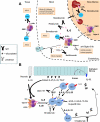Biologic therapies targeting eosinophils: current status and future prospects
- PMID: 25754717
- PMCID: PMC4418449
- DOI: 10.1016/j.jaip.2015.01.013
Biologic therapies targeting eosinophils: current status and future prospects
Abstract
The recent explosion in the number of biologic therapies in clinical development for the treatment of eosinophilic disorders is unprecedented. As these agents become available for clinical use, the selection of the most appropriate agent for a given patient will become increasingly complicated. The aims of this review were 2-fold: (1) to present the lessons learned from clinical trials using the first generation of eosinophil-targeted biologics (anti-IL-5 antibodies) and (2) to discuss the advantages and potential limitations of currently available and novel targeted therapies to treat eosinophilic disorders.
Keywords: Asthma; Benralizumab; Eosinophilic gastrointestinal disorders; Hypereosinophilic syndrome; Mepolizumab; Reslizumab; mAb.
Published by Elsevier Inc.
Figures
References
Publication types
MeSH terms
Substances
Grants and funding
LinkOut - more resources
Full Text Sources
Other Literature Sources
Medical
Research Materials


